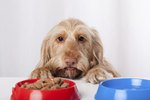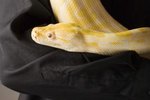Endoscopy provides a minimally invasive method for viewing the inside of your dog's body. An endoscope is a long, narrow device equipped with a camera and used for various visual evaluations of internal body parts. The colonoscopy is one such test in which a flexible endoscope is inserted into the anus and guided through your dog's lower gastrointestinal tract to examine the rectum, colon, cecum and ileocecal valve.
Diagnosis Through Colonoscopy
If your dog has presented with such symptoms as persistent diarrhea, blood in his stools, difficulty defecating or unexplained weight loss, your veterinarian will begin the diagnostic process by performing laboratory screenings on blood, stool and urine samples, and by performing basic abdominal radiographs. If these tests reveal no significant findings, your veterinarian may administer a colonoscopy. A colonoscopy is useful in detecting:
- Inflammatory bowel disease.
- Tumors.
- Fungal infections.
- Ulcers.
- Occult bleeding.
A colonoscopy gives an additional diagnostic advantage. If any suspicious areas or lumps are observed, a biopsy device can be inserted into the tube of the endoscope to take tissue samples. These samples are then send to a laboratory for analysis. This histopathology is valuable in diagnosing:
- Cancer.
- Infection.
- Fibrosis.
- Inflammation.
The Colonoscopy Procedure
In order for the endoscope to pass smoothly through the gastrointestinal tract and obtain a clear view, your dog will need to undergo a bowel preparation that will clear his system of all fecal material. This is accomplished during a hospital stay that begins a day or two before the colonoscopy procedure. While your dog is in the hospital, he will be allowed to drink water, but food will be withheld for 24 to 36 hours prior to the procedure. Warm water enemas and oral solutions will be administered to completely empty his bowels.
Veterinary colonoscopies must be performed under general anesthesia. Pre-anesthetic screenings, including blood panels and, in older patients, chest radiographs, will be performed. Once your dog is under anesthesia, he will be hooked up to equipment that will monitor his vital signs. Once the endoscope is inserted, the doctor advances the device through the gastrointestinal tract while observing the images on a table side monitor. Pictures may be taken for future reference, and tissue samples taken for biopsy. Since diseased tissue can sometimes appear normal on visual inspection, multiple samples are usually taken to increase the likelihood of a definitive diagnosis. Once your dog has been anesthetized, the colonoscopy procedure takes 20 to 60 minutes, depending on the extent of abnormal findings.
After the Procedure
Once the colonoscopy has concluded, your dog will be placed in a recovery ward where he will be monitored as he awakens from the anesthesia. Most patients are discharged from the hospital on the same day as the colonoscopy. When you pick up your dog from the hospital, you will be provided with instructions for caring for him once he is home. Seek details on any instructions that are not clear to you. The biopsy samples are sent the to laboratory within 24 hours of the procedure, and your veterinarian will receive the results of the histopathology three to five days after that.
Limitations and Risks
A colonoscopy is generally considered to be a safe procedure. You may observe some blood in your dog's stool for the first day or so, as this is the most common side effect of a colonoscopy. Risks that can occur during a colonoscopy include perforation of the intestines and anesthetic complications. The disadvantage of a colonoscopy is its inability to obtain full thickness biopsies, meaning samples that include more than just the surface tissue from the intestinal wall. As a result, disease cannot always be detected and subsequent exploratory surgery may be necessary to obtain the full thickness biopsy samples. Another limitation of the colonoscopy is that the endoscope cannot access the entire length of the gastrointestinal tract, which can allow disease in the unreachable portion to go undetected.
If your veterinarian has recommended a colonoscopy procedure for your dog, address all of your concerns before the day of the procedure so you will be prepared and know what to expect. Once a diagnosis has been made, your veterinarian will be able to discuss treatment options to improve your dog's quality of life.



